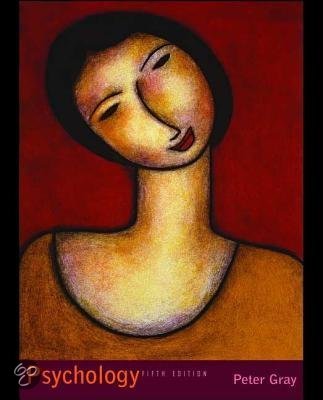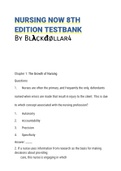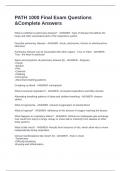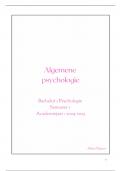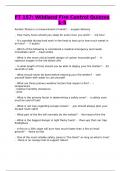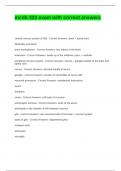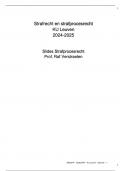The nervous system
The central nervous system consists of the brain and the spinal cord.
The peripheral nervous system consists of the extensions from the central nervous system
Cranial nerves project directly from the brain (12 pairs).
Spinal nerves project from the spinal cord (31 pairs).
Somatosensation are senses that derive from the whole body as opposed to those senses
that come from the special sensory organs of the head.
The brain
The brainstem regulates basic things like your heartbeat and breathing, also how to stand,
walk and sit.
- The medulla and pons organise reflexes that are more complex than spinal reflexes.
The hypothalamus regulates your internal environment (e.g. appetite/thirst/temperature). It
makes sure that there is an ideal situation for all the biological processes.
(Know the brain parts! Names, location and function)
The prefrontal cortex makes plans and interrupts current behaviour if necessary.
The association cortex, mainly the parietal and temporal lobes.
The hippocampus plays an important role in storing new memories and in spatial orientation.
Looks like a seahorse.
The premotor cortex is involved in making action plans. It makes a specific plan of
movement and sends that to the primary motor cortex, basal ganglia and cerebellum.
The visual cortex (in the occipital lobes) analysis of what your eyes picked up.
- information goes from the eyes to the visual cortex via the thalamus
The thalamus is a central hub for sensory information (except smell!) The thalamus can
suppress signals so it will not get processed in the rest of the brain (e.g. sounds during
studying). It connects various parts of the brain with one another.
The amygdala plays an important role in emotions, especially fear
The cerebellum (little brain) uses information of the senses to control precise, previously
learned movements (without feedback (‘fast’ movements)).
The somatosensory cortex receives signals of tactile sense (sense of touch)
- via the thalamus
The basal ganglia uses information of the senses to control precise, previously learned
movements (with feedback (‘slow’ movements)).
The primary motor cortex is involved in executing delicate movements (unlocking something)
The language centres (for most people in the left half of the brain - 90%)
- Broca’s area: mostly syntax - close to the motor and premotor cortex
- Broca’s aphasia - lack of fluency
- Wernicke’s area: mostly meaning of sentences - located in the association cortex
- Wernicke’s aphasia - speech retains its fluency but loses its meaning
The limbic system is the border dividing the evolutionarily older part of the brain below it from
the newest part above it.
Left side of the brain receives visual information from the right side of your visual field (vice
versa). The left side of the brain feels and controls the right side of the body and vice versa.
- Connected by the corpus callosum.
- Split brain patients: Corpus callosum is cut through to avoid elliptical attacks
going through the whole brain. Right side = no problem, left = guessing.
Aphasia, any loss of language ability resulting from brain damage.
The central nervous system consists of the brain and the spinal cord.
The peripheral nervous system consists of the extensions from the central nervous system
Cranial nerves project directly from the brain (12 pairs).
Spinal nerves project from the spinal cord (31 pairs).
Somatosensation are senses that derive from the whole body as opposed to those senses
that come from the special sensory organs of the head.
The brain
The brainstem regulates basic things like your heartbeat and breathing, also how to stand,
walk and sit.
- The medulla and pons organise reflexes that are more complex than spinal reflexes.
The hypothalamus regulates your internal environment (e.g. appetite/thirst/temperature). It
makes sure that there is an ideal situation for all the biological processes.
(Know the brain parts! Names, location and function)
The prefrontal cortex makes plans and interrupts current behaviour if necessary.
The association cortex, mainly the parietal and temporal lobes.
The hippocampus plays an important role in storing new memories and in spatial orientation.
Looks like a seahorse.
The premotor cortex is involved in making action plans. It makes a specific plan of
movement and sends that to the primary motor cortex, basal ganglia and cerebellum.
The visual cortex (in the occipital lobes) analysis of what your eyes picked up.
- information goes from the eyes to the visual cortex via the thalamus
The thalamus is a central hub for sensory information (except smell!) The thalamus can
suppress signals so it will not get processed in the rest of the brain (e.g. sounds during
studying). It connects various parts of the brain with one another.
The amygdala plays an important role in emotions, especially fear
The cerebellum (little brain) uses information of the senses to control precise, previously
learned movements (without feedback (‘fast’ movements)).
The somatosensory cortex receives signals of tactile sense (sense of touch)
- via the thalamus
The basal ganglia uses information of the senses to control precise, previously learned
movements (with feedback (‘slow’ movements)).
The primary motor cortex is involved in executing delicate movements (unlocking something)
The language centres (for most people in the left half of the brain - 90%)
- Broca’s area: mostly syntax - close to the motor and premotor cortex
- Broca’s aphasia - lack of fluency
- Wernicke’s area: mostly meaning of sentences - located in the association cortex
- Wernicke’s aphasia - speech retains its fluency but loses its meaning
The limbic system is the border dividing the evolutionarily older part of the brain below it from
the newest part above it.
Left side of the brain receives visual information from the right side of your visual field (vice
versa). The left side of the brain feels and controls the right side of the body and vice versa.
- Connected by the corpus callosum.
- Split brain patients: Corpus callosum is cut through to avoid elliptical attacks
going through the whole brain. Right side = no problem, left = guessing.
Aphasia, any loss of language ability resulting from brain damage.

